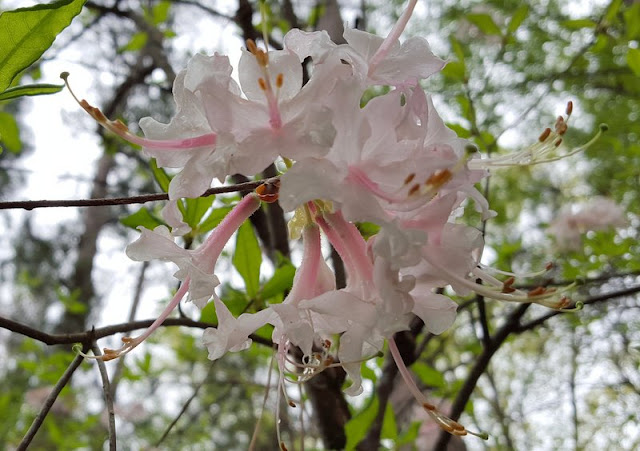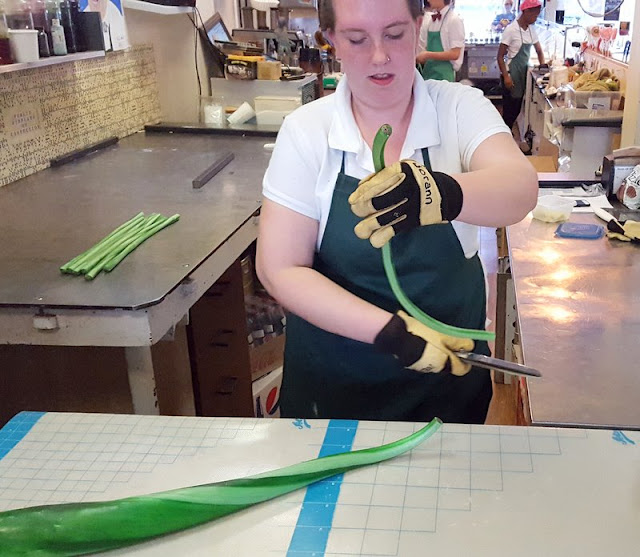We are on a roll of visiting state capitols, so we made the ten mile trip into Tallahassee to see Florida's. After the beautiful domes and spiral staircases of other capitol buildings, we were a little underwhelmed with the outside of this one. This capitol looked more like one of the surrounding business buildings, rather than a typical state capitol. We did like the playful dolphin fountains out front, right behind Denisa.
Just like its plain exterior, we didn't find any fancy interior either. The closest thing to a grand rotunda is the Florida state seal in the plaza level.
It took us three different elevator rides, but we finally made our way to the observation deck on the 22nd floor. (One of the elevators would only take us as high as the 21st floor--home of Marco Rubio's office.) From the observation deck, we looked over the small city downtown of Tallahassee, as well as 80 miles in every direction on this clear day. This view to the west overlooks the Florida State University campus, a place we will visit later. Even from this distance we can see the cranes that are working on the renovation of the FSU stadium.
Like the other states we have visited, Florida has restored its old capitol back to its original grandeur. Right in front of the new capitol that was built in 1977, the historical capitol building looks like it did in 1902--complete with red striped window awnings. We were told that area television stations still prefer to have legislative news spots filmed on the picturesque steps of the historical capitol, rather than the new one. We can certainly see why.
Likewise, the historic senate chambers were also more picturesque, especially with Mark presiding over the legislative business of the day.
In keeping with the restoration back to its 1902 grandeur, we became part of the crowd of the day. No, we didn't have someone there to take the picture for us. This picture was actually two separate pictures that we took that day, melded together by Mark's computer skills. It's nice to know that he is still using those skills even after he is retired.
After our two-hour parking meter expired, we left downtown for the northern section of the city. We wanted to experience one of the many "canopy roads" of Tallahassee where the trees meet in the middle to completely shade the street.
It was a beautiful weather day, and we needed a place for a walk. So we headed to the Dorothy B. Oven Park. We made several laps around the park, enjoying the pond and one of Denisa's new favorite plants--the native azalea. That's the bright yellow plant behind Denisa on the other side of the pond.
They come in all colors, and this light pink bloom shows the fascinating way they bloom. We've been enjoying the blooms of the traditional azalea for the last two states, so now Florida has introduced us to the native azalea.
As soon as we walked into this park, Denisa knew she would like spending time here. Possibly her favorite smell of all time is the sweet fragrance of the citrus bloom. She walked slower through that section of the park where the four citrus trees were blooming. It's amazing that this one little bloom has such a powerful and delicious smell. Denisa knows you aren't supposed to pick flowers in parks, but she couldn't resist taking this little piece of sweet Florida citrus with her today.
Sweet must be the theme of the day, because our next stop was a local candy store--Lofty Pursuits. We love factory tours, and this store makes old-fashioned hard candy by hand. When we got there, our candy chef was already pulling the sweet candy over a stainless steel hook--blending the colors and incorporating air.
He then had three different colors of sugar blobs--dark brown, light brown, and cream--as Denisa watched his technique up close.
After forming the three different colors into a candy log, he started winding one end of it into tighter ropes of candy that he would cut off with his candy scissors. The ropes then go through the metal tool on the table behind him, wrinkling them into crooked ropes.
When they get cool, the candy breaks into pieces called humbugs. Everyone got a warm sample to try. The flavor of the day, horehound, was not our favorite. Denisa remembers that her Dad loved horehound candy, so she tried it with an open mind. Her genetics must have kicked in, because it was definitely tastier than she remembered.
Watching humbugs being made was fun, but we had really hoped to see some of the "victorian candies." We took a photo of the sample designs, that illustrate the tiny candies that somehow have a picture of the flavor inside each piece. How do they do that?
When we found out they were making watermelon candies in an hour or so, we wasted some time eating their home-made ice cream. We tried two of their original flavors--Guava cheesecake and Cherry Oblivion. When Denisa saw a music store across the parking lot, she made good use of the extra time doing something she loves even more than eating ice cream--playing one of their pianos.
We returned to the candy store in time to see the full process of making watermelon candy. Get ready for lots of pictures as we attempt to answer the question of "How do they get all those little black watermelon seeds into a tiny piece of candy?" They start with a 310 degree pot of sugar water that already has the watermelon flavoring added. This is poured into a square mold to keep it from running all over the cooling table.
While the square mold is still in place, red coloring is added to the top section, green to the bottom, and black to the middle portion. She also sprinkled the red section with ascorbic acid to give the sweet candy that sour tangy flavor. When the sides of the mold are removed, we see the candy is already cooling enough to hold the square shape.
By this stage, our candy maker has already used the stainless steel hook to mix the white powder into the red. This also incorporates air into the candy, lightening the red clump of candy into pink. She rolled the black candy into a big hot dog size log that is then enveloped in the watermelon pink layer.
She rolled that pink roll (with the black log inside) into a long snake, then cut it into 12 pieces using her giant candy scissors.
These 12 pieces are stacked together, then rolled into a longer cylinder that looks pink from the outside (but we know those black logs are hidden inside). In the meantime, she has mixed some pink into half of the green to lighten it to the lighter green shade. So we have two shades of green that will make that variegated green rind of the watermelon.
That green striped rectangle rind is rolled around the pink cylinder inner section. She explained that she didn't color enough of her original candy green. In a perfect world the green would completely cover the entire length of the pink.
Now she begins twisting and spinning the completed cylinder until it is the small diameter of a piece of candy.
A whack with the scissors separates the candy into strings that will be cooled on the stainless table behind her.
After cooling, a sharp hit against an anvil breaks the stick into bite size pieces.
Everyone that had been patiently watching this 45-minute process got a warm free sample of watermelon candy. Those twelve little black seeds are perfectly dispersed in every slice, surrounded by the two-tone green rind. There would have been two pieces of candy in the picture, but Mark popped his free sample into his mouth as soon as it hit his hand.
It was a fascinating process, and another free factory tour on a small scale. One of our young friends watching the demonstration announced, "I need to come back here every day!" We think that would be an awesome idea! It was truly a sweet day in Tallahassee!


























No comments:
Post a Comment